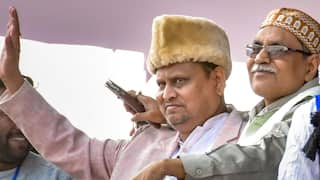Opinion: Understanding FSHD — The 3rd Most Common Muscular Dystrophy — And The Importance Of Early Diagnosis
An estimated 1 in 8,000 individuals, or 870,000 people worldwide, are affected by Facioscapulohumeral muscular dystrophy (FSHD). It strikes men, women, and children of all races and ethnicities.

Dr Anup Rawool
Facioscapulohumeral muscular dystrophy (FSHD) is a genetic condition that affects muscle function, often making everyday tasks — like smiling or lifting one’s arms — difficult. For individuals suffering from it and their families, the journey to diagnosis can be overwhelming, as they confront the physical, emotional, and social challenges posed by the disease. It is the third most common muscular dystrophy, after myotonic dystrophy and dystrophinopathies.
An estimated 1 in 8,000 individuals, or 870,000 people worldwide, are affected by this dystrophy. FSHD strikes men, women, and children of all races and ethnicities. The typical age of onset is 20 to 30 years, but around 10% of people develop symptoms before the age of 10. This inherited condition can affect family members across generations.
However, it is essential to understand that FSHD is not caused by personal actions or lifestyle choices but by specific molecular changes encoded in DNA. Recognising and diagnosing FSHD early is crucial for better management and quality of life.
What Causes FSHD?
FSHD results from a unique genetic and epigenetic mechanism. It is primarily caused by a contraction in the D4Z4 repeat region on chromosome 4, which normally keeps the DUX4 gene silenced. In individuals with FSHD, this contraction leads to the inappropriate activation of the DUX4 gene in muscle cells, triggering a toxic cascade that damages muscle tissue.
FSHD is further categorised into two subtypes:
- FSHD1: Caused by a reduction in the number of D4Z4 repeats on a permissive chromosome 4 haplotype that allows DUX4 activation.
- FSHD2: Associated with mutations in the SMCHD1 gene or other regulatory factors, which also lead to DUX4 activation in the presence of a permissive chromosome 4 haplotype.
This molecular mechanism makes FSHD distinct from other muscular dystrophies. Unlike Duchenne muscular dystrophy, which results from mutations in the DMD gene, or myotonic dystrophy caused by repeat expansions, FSHD arises from a combination of structural changes and epigenetic deregulation.
Signs And Symptoms Of FSHD
FSHD often presents with:
- Facial Weakness: Difficulty smiling, whistling, or closing the eyes completely
- Shoulder Blade Weakness: Leading to scapular winging (protruding shoulder blades)
- Upper Limb Weakness: Difficulty raising arms or lifting objects
- Asymmetric Progression: Weakness typically starts in the face, shoulders, and arms and later affects the legs, ankles, feet, and pelvic girdle.
Other symptoms may include:
- Non-Muscle Features: Some individuals develop retinal vascular abnormalities (coats-like retinopathy) or hearing loss, particularly in childhood-onset cases.
- Lower Back Pain and Protruding Abdomen: Due to weakened core muscles.
FSHD symptoms can vary widely among individuals, making early diagnosis critical to avoiding delays in care. For many, the journey to diagnosis is fraught with questions and delays. A lack of awareness about FSHD means symptoms are often dismissed as general fatigue or unrelated health issues. This underscores the need for education and the importance of listening to what the body tells us, even when the signs seem insignificant.
Why Conventional NGS Can’t Diagnose FSHD
Unlike most genetic conditions caused by single-gene mutations or small insertions/deletions, FSHD arises from a structural variant — a contraction in the D4Z4 repeat array. Conventional next-generation sequencing (NGS) is not designed to detect these larger structural changes or assess the epigenetic landscape of the region.
For FSHD diagnosis, Optical Genome Mapping (OGM) is a cutting-edge tool that offers a distinct advantage:
- Precision: It accurately measures the number of D4Z4 repeats and determines the presence of a permissive haplotype required for DUX4 activation.
- Comprehensive Analysis: Unlike NGS, OGM can detect structural changes and large rearrangements critical for FSHD diagnosis.
How Is FSHD Diagnosed?
Diagnosis is more than putting a name to a condition, it is a pathway to clarity to understanding the disease, treatment and management according to the mutation. Diagnosing FSHD involves a combination of clinical and molecular approaches:
- Clinical Examination: Assessing patterns of muscle weakness and taking a detailed family history.
- Biochemical Tests: Elevated levels of muscle enzymes (e.g., creatine kinase) may indicate muscle damage.
- Electromyography (EMG): Evaluating electrical activity in affected muscles.
- Advanced Genetic Testing: Techniques like OGM and targeted testing for D4Z4 repeat contractions and permissive haplotypes provide definitive answers.
These tools not only confirm the diagnosis but also help identify the specific subtype (FSHD1 or FSHD2), which can guide family planning and management strategies.
Why Early Diagnosis Matters
Early diagnosis is crucial for several reasons:
- Personalised Management: Identifying the genetic basis of the disease allows tailored interventions, such as physical therapy or lifestyle modifications, to slow disease progression.
- Family Planning: Understanding inheritance patterns (autosomal dominant for FSHD1 and digenic for FSHD2) helps families assess reproductive risks and explore options like preimplantation genetic testing (PGT).
- Clarity and Education: It shifts the narrative away from blame and emphasises the biological nature of the condition.
Living With FSHD
While there is currently no cure for FSHD, several management strategies can significantly improve quality of life. Support from family, friends, advocacy groups, and genetic counsellors is vital in helping individuals navigate the challenges of FSHD. Genetic counsellors play a crucial role in helping families understand the implications of the diagnosis, and offering guidance for the future.
- Physical Therapy: Customised exercise programmes to maintain strength without overexertion.
- Assistive Devices: Braces and mobility aids can help with daily activities.
- Scapular Fixation Surgery: A surgical option for severe shoulder blade winging.
- Speech Therapy: For individuals with significant facial muscle weakness.
- Lifestyle Modifications: Avoiding overuse of muscles while staying active.
Additionally, multidisciplinary care — involving neurologists, physiatrists, geneticists, and counsellors — plays a critical role in addressing the diverse needs of individuals with FSHD.
Research And Future Hope
Ongoing research offers hope for individuals with FSHD. Key areas include:
- Gene Therapy: Efforts to silence DUX4 using antisense oligonucleotides or CRISPR-based approaches
- Small Molecules: Investigating drugs that modulate the epigenetic landscape to suppress DUX4
- Regenerative Medicine: Exploring stem cell-based therapies to repair damaged muscle tissue
While these therapies are in early stages, they represent a growing commitment to finding effective treatments.
The Role Of Medical Genetic Consultation & Counselling
A medical genetic consultation is essential for individuals with FSHD and their families. A medical geneticist can help interpret complex genetic test results, such as differentiating between FSHD1 and FSHD2, and offer guidance on reproductive options, including prenatal testing and preimplantation genetic testing (PGT). They also provide emotional support and connect families with relevant advocacy groups. Additionally, a genetic counsellor can facilitate the counselling process, ensuring that families understand the condition and available resources.
FSHD reminds us of the complexity of our genetic makeup and the challenges that can arise when things go awry. By embracing advanced diagnostic tools like Optical Genome Mapping and fostering awareness, we can empower individuals and families with the knowledge and resources they need.
Through early diagnosis, multidisciplinary care, and a growing body of research, there is hope for better management and, ultimately, a future cure for FSHD.
The writer is Associate Director, Medical Genetics, and Head, Scientific and Medical Affairs at MedGenome.
[Disclaimer: The information provided in the article, including treatment suggestions shared by doctors, is intended for general informational purposes only. It is not a substitute for professional medical advice, diagnosis, or treatment. Always seek the advice of your physician or other qualified healthcare provider with any questions you may have regarding a medical condition.
The opinions, beliefs, and views expressed by the various authors and forum participants on this website are personal and do not reflect the opinions, beliefs, and views of ABP Network Pvt. Ltd.]
Check out below Health Tools-
Calculate Your Body Mass Index ( BMI )






































